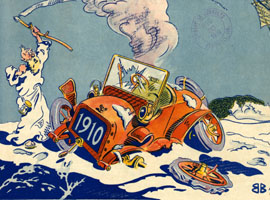From resolutions to revelry
Prof. Alexis McCrossen is researching the history of American New Year's observances for a new book.

DALLAS (SMU) – In the United States' earliest days, New Year's Day was a time to pay respect, reflect and render accounts. The revelry came later, says Alexis McCrossen, SMU professor of history. McCrossen recently received a prestigious one-year fellowship from the National Endowment for the Humanities to support her work on her book about the history of American New Year's observances.
"There is something deeply symbolic about the new year," McCrossen said. "Historically it has been when we made sense of the fact that our time is finite, yet recognized the new beginning offered by a new year. The more I research, the more I think our current New Year's celebrations are impoverished."
Beginning with George Washington and lasting through Herbert Hoover's presidency, thousands of Americans lined up to pay their respects to the president at annual New Year's Day White House receptions. Gifts were presented on New Year's Day, not Christmas and important events, like the signing of the Emancipation Proclamation, took place then.
Abraham Lincoln signed the Emancipation Proclamation to free slaves on Jan. 1, 1863, ending what had been known to slaves as "Heartbreak Day." Slave families often were split on Jan. 1, when slave owners balanced their books by auctioning off slaves.
The revelry of New Year's Eve didn't begin until the late 1800s, she says. The first time ball dropped in New York's Times Square on Dec. 31, 1907, launching an annual celebration that has continued each year, except for 1942 and 1943, when the celebration was cancelled because of wartime blackouts.
 Alexis McCrossen |
McCrossen will finish her book, Resolutions and Revelry: New Year’s Observances in the United States, with the help of the National Endowment of the Humanities fellowship for academic year 2016-2017. She is one of six Texas scholars and 83 scholars nationally to receive the award, designed to support vital research, education and public programs in the humanities.
McCrossen's work is part of an emerging area in historical research, temporal studies, a new way of looking at the past through the study of measurement, importance and recognition of time.
She received her first NEH fellowship in 1999-2000 for her work on the history of timekeeping in the United States. Her book, Marking Modern Times: Clocks, Watches and Other Timekeepers in the United States, was published in 2013 and Holy Day, Holiday: The American Sunday, was published in 2000. Her work has also been supported by SMU's Ford Research Fellowship.